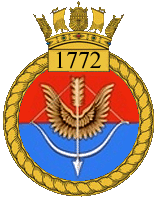
The 7th Carrier Air Group was an aircraft carrier air group of the Royal Navy's Fleet Air Arm. It was formed in June 1945, at HMS Nabthorpe, a Royal Navy Mobile Operatioral Naval Air Base (MONAB) at the Royal Australian Air Force (RAAF) base RAAF Station Schofields at Schofields, New South Wales, in Australia. The group was initially embarked on HMS Indefatigable (R10).

1790 Naval Air Squadron was a Naval Air Squadron of the Royal Navy's Fleet Air Arm (FAA). It was formed on 1 January 1945 at RNAS Burscough as a night fighter squadron. It was initially equipped with the Fairey Firefly I, replaced in May 1945 by the Firefly INF, which was fitted with a US-derived ASV radar. The squadron joined HMS Vindex on 24 June, bound for Australia, with the ship arriving at HMS Nabthorpe 2 days before the war in the Far East ended. The squadron was disbanded on 3 June 1946 at Devonport.

Royal Naval Air Station Burscough, was a Fleet Air Arm (FAA) naval air station which was 1.5 miles (2.4 km) southwest of Burscough, Lancashire. The Admiralty acquired 650 acres (2.6 km2) of land in December 1942 and the airfield was built with four narrow runways and several hangars, being commissioned on 1 September 1943.

1701 Naval Air Squadron was a Naval Air Squadron of the Royal Navy's Fleet Air Arm (FAA). It was formed in February 1945 at HMS Daedalus, RNAS Lee-on-Solent, as an amphibian bomber reconnaissance squadron. It was equipped with Supermarine Sea Otter, and the squadron joined HMS Begum in April 1945 bound for the Far East. The squadron was intended to join the newly established Mobile Naval Air Bases for Air Sea Rescue duties. 'B' Flight joined MONAB IV at RNAS Ponam in the Admiralty Islands in May 1945 and embarked in HMS Reaper in October 1945. 'A' Flight joined MONAB VI at RNAS Maryborough, Queensland, Australia in June 1945. The flights re-grouped in the Autumn of 1945 at HMS Nabcatcher, RNAS Kai Tak, Hong Kong, where it disbanded during August 1946.

778 Naval Air Squadron was a Naval Air Squadron of the Royal Navy's Fleet Air Arm. During the Second World War the squadron was a Service Trials Unit (STU) initially based at HMS Daedalus, RNAS Lee-on-Solent, Hampshire, England before moving to HMS Condor, RNAS Arbroath, Angus, Scotland on 6 July 1940. The squadron tested all types of aircraft that could be used by the Royal Navy. Key to this was testing new types for deck landing on aircraft carriers. Such aircraft included various types of Supermarine Seafires, Grumman Hellcats, Grumman Martlets, Grumman Avengers, and Vought Corsairs. The squadron was reformed on 5 November 1951 with Douglas Skyraider AEW.1 but was disbanded on 7 July 1952 to form the basis of 849 Naval Air Squadron.

706 Naval Air Squadron was a Naval Air Squadron of the Royal Navy's Fleet Air Arm. Established as a fighter and torpedo-bomber training unit in Australia at the end of World War Two, it was briefly reformed as a helicopter squadron in the early 1950s, before becoming a helicopter training unit in 1962, and operating until 1998.
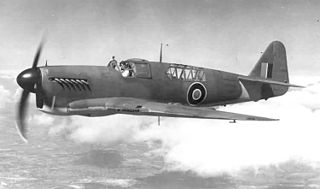
1791 Naval Air Squadron was a Naval Air Squadron of the Royal Navy's Fleet Air Arm (FAA). It was formed on 15 March 1945 at HMS Daedalus, RNAS Lee-on-Solent as a Night Fighter squadron. It was equipped with Fairey Firefly NF.Mk I. The squadron joined HMS Puncher in June for deck landing practice but saw no action. Following V-J Day the squadron was disbanded on 23 September 1945 at HMS Ringtail, RNAS Burscough.

707 Naval Air Squadron was a Naval Air Squadron of the Royal Navy's Fleet Air Arm which disbanded during February 1995. It was active during the Second World War forming during February 1945 as a Radar Trials Unit, disbanding in October of the same year. It reformed December 1964, as an Advanced and Operational Flying Training Commando helicopter squadron.

719 Naval Air Squadron was a Naval Air Squadron of the Royal Navy's Fleet Air Arm. It initially formed in 1944 as a Fighter Air Firing Training Squadron, at HMS Vulture, RNAS St Merryn, within the School of Air Combat, but at the start of 1945 it disbanded into 794 Naval Air Squadron. The squadron reformed in 1946 at HMS Owl, RNAS Fearn, as a Strike Training Squadron, before moving to HMS Gannet, RNAS Eglinton, where it became an Anti-submarine Training Squadron, disbanding there in 1949. The squadron reformed the following year at HMS Gannet as the Naval Air Anti-submarine School and remained there becoming the Naval Anti-Submarine Operational Flying School, eventually disbanding in 1959. However, in 1960, the squadron reformed, again at HMS Gannet, as the Joint Anti-submarine School Flight, this time operating helicopters. 719 Naval Air Squadron was granted first line status on 5 October 1961 and renumbered to 819 Naval Air Squadron.
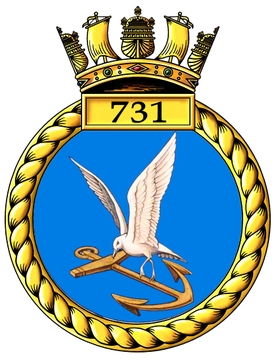
731 Naval Air Squadron was a Naval Air Squadron of the Royal Navy's Fleet Air Arm (FAA). It was active between 1943 and 1945 and its sole role throughout its formation was a Deck Landing Control Officer training squadron. Through this role the squadron pilots were nicknamed 'Clockwork Mice'. It was based out of the purpose built airbase, commissioned as HMS Peewit, known as Royal Naval Air Station East Haven, in Scotland, as part of the Deck Landing Training School there.
735 Naval Air Squadron was a Naval Air Squadron of the Royal Navy's Fleet Air Arm. It was active from 1943 as an ASV Radar Training Unit. Forming at HMS Nightjar, at RNAS Inskip, Lancashire, in 1944 the squadron moved to HMS Ringtail, RNAS Burscough, also in Lancashire. Various flights from the squadron moved on to form other Naval Air Squadrons, with the squadron eventually disbanding in 1946.

757 Naval Air Squadron was a Naval Air Squadron of the Royal Navy's Fleet Air Arm. It was first formed as a Telegraphist Air Gunner Training Squadron in 1939, operating out of RNAS Worthy Down, but after three months it went into abeyance, only to reform again in the same role, at the same location, in 1941 and operating until 1942. It then reformed as a Fighter Pool Squadron & Operational Training Unit at RNAS Puttalam, in Sri Lanka, in 1943. After a brief spell at RNAMY Tambaram, in India, the squadron finally disbanded at RNAS Katukurunda, in Sri Lanka, at the beginning of 1946.
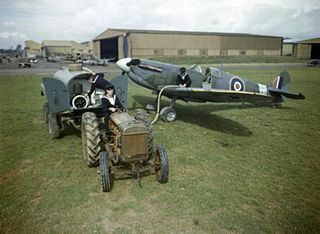
761 Naval Air Squadron was a Naval Air Squadron of the Royal Navy's Fleet Air Arm. It was formed at HMS Heron, RNAS Yeovilton, as the Advanced Training Squadron of the Fleet Fighter School, in 1941. The squadron moved to HMS Dipper, RNAS Henstridge, in 1943, as part of the No. 2 Naval Air Fighter School. It remained at HMS Dipper and in this role, until January 1946, when the squadron disbanded.

772 Naval Air Squadron was a Naval Air Squadron of the Royal Navy's Fleet Air Arm which last disbanded during September 1995. 772 Naval Air Squadron formed as a Fleet Requirements Unit out of ‘Y’ Flight from 771 Naval Air Squadron at RNAS Lee-on-Solent in September 1939. While the headquarters remained there, floatplanes were operated out of RNAS Portland, however, mid 1940 saw the whole squadron move north to RNAS Campbeltown and roughly twelve months afterwards the short distance to RNAS Machrihanish. The unit moved to RNAS Ayr in July 1944 and became the Fleet Requirements Unit School. In January 1946 the squadron moved to RNAS Burscough in Lancashire, before moving to RNAS Anthorn in Cumberland, in May. It became the Northern Fleet Requirements Unit upon moving to RNAS Arbroath, in June 1947, but disbanded into 771 Naval Air Squadron in October. 772 Naval Air Squadron reformed as a Helicopter Support Squadron at RNAS Portland in September 1974. In September 1977 the squadron took over responsibility for a number of Ships' Flights of Royal Fleet Auxiliary ships. The squadron was used to reform 848 Naval Air Squadron for the Falklands Task Force in 1982, with the Ships' Flights absorbed into 847 Naval Air Squadron. In August 1982 it took on the Anti-Submarine Warfare Flight from 737 Naval Air Squadron and between 1983 - 1985 a Search and Rescue Flight operated out of RNAS Lee-on-Solent.

776 Naval Air Squadron was a Naval Air Squadron of the Royal Navy's Fleet Air Arm which last disbanded at the end of October 1945. 776 Naval Air Squadron formed as a Fleet Requirements Unit at HMS Daedalus, RNAS Lee-on-Solent, at the start of 1941. It operated a detachment at RN Air Section Speke in 1941 and one at RAF Woodvale in 1942, with the squadron wholly moving to Speke in the October. 1943 saw further detachments and these were deployed at RAF Llanbedr, RAF Millom, RAF Usworth and RAF Waltham. In April 1945, the Woodvale detachment was reabsorbed into the squadron when it relocated there, the airbase now operated by the Admiralty and known as HMS Ringtail II. It moved to HMS Ringtail, RNAS, Burscough, at the start of October 1945.

784 Naval Air Squadron was a Naval Air Squadron of the Royal Navy's Fleet Air Arm which last disbanded in the autumn of 1946. 784 NAS was a Night Fighter Training Squadron which formed at HMS Daedalus, RNAS Lee-on-Solent, Hampshire, in June 1942, moving to HMS Nighthawk, RNAS Drem, East Lothian, in October 1942. Squadron Personnel were also detached to the Naval Air Radio Installation Unit at RAF Christchurch, in 1943 and in the same year, a number of crews were attached to RAF night fighter squadrons, with two officers gained Distinguished Flying Crosses. In 1944, three squadron Flights were attached for service to each of 813, 825 and 835 Naval Air Squadrons, embarked in the escort carriers HMS Campania, HMS Vindex, and HMS Nairana respectively, on convoy protection duties. At the beginning of 1946 the squadron moved to Wales, operating out of HMS Goldcrest II, RNAS Brawdy.

787 Naval Air Squadron was a Naval Air Squadron of the Royal Navy's Fleet Air Arm which disbanded in January 1956. It formed in March 1941, at HMS Heron, RNAS Yeovilton, out of 804 Naval Air Squadron as a Fleet Fighter Development Unit. Almost every type of fighter was received by the squadron for testing and evaluation for naval use. A move to RAF Duxford in June 1941 saw it become the Naval Air Fighting Development Unit, attached to the Royal Air Force's Air Fighting Development Unit. The squadron undertook rocket projectile test, continuous development of fighter tactics and even helping Torpedo Bomber Reconnaissance squadrons in evading fighter attack. Post Second World War it continued its trials task and also undertook Rebecca radar trials and ASH, US-built air-to-surface vessel radar trials.

798 Naval Air Squadron was a Naval Air Squadron of the Royal Navy's Fleet Air Arm which disbanded in March 1946. It formed at RNAS Lee-on-Solent, in October 1943, to provide advanced conversion courses, it initially operated with various single and twin-engined aircraft. Twin-engined aircraft broke away to become 762 Naval Air Squadron during March 1944. It had a detachment at RNAS Stretton for operational training for new Fairey Barracuda squadrons, but returned to HMS Daedalus at the beginning of August. The unit’s role changed slightly during 1945, providing refresher training, including Fleet Air Arm ex-Prisoners of War at RNAS Halesworth. The squadron moved to RNAS Hinstock, although operated out of its satellite RNAS Peplow, during November 1945.
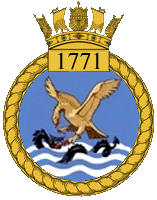
1771 Naval Air Squadron was a Naval Air Squadron of the Royal Navy's Fleet Air Arm which disbanded at HMS Nabbington, RNAS Nowra, near Sydney, in October 1945. Notably, the squadron was the first British & Commonwealth unit to fly over Japan in the Second World War. The squadron formed at HMS Heron, RNAS Yeovilton at the start of February 1944, as a Fighter Squadron and also operated from HMS Ringtail, RNAS Burscough, and HMS Landrail, RNAS Machrihanish, with deck landing training on the escort carriers HMS Trumpeter and HMS Ravager before embarking in the fleet carrier HMS Implacable in September. It was involved in sorties over Norway including reconnaisance of the German battleship Tirpitz and other anti-shipping strikes. The squadron remained in HMS Implacable and joined the British Pacific Fleet participating in attacks on the Caroline islands and the Japanese home islands, and becoming part of the 8th Carrier Air Group.
